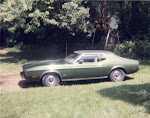There is a campaign for the "Top 100 Public Spaces in the U.S." and someone has written a very nice nomination for the Uptown Normal (Traffic) Circle. It's actually in the "Hot 90" nominations at this point!
All you need to do to vote is register (email address and password), respond to the verification email that you will receive right after registering, and vote by giving "The Circle: Uptown Normal, Illinois" your chips.
It's a great way to share this wonderful space with the world! Please vote by October 20 15!
Update (10/11): The Circle moved up to first and now, second in the list. The voting goes until Oct. 15, so please encourage everyone to vote!
Now, you can have your vinyl-sided house, three-car garage, deck, and your own home-grown produce without messing up your manicured lawn!
Some subdivisions are being built around farms or are including a community green space for farming/gardening. This is an idea worth considering! Forget the space for kids to play or for people to walk their dogs. Now, we want space to grow our own produce! (I guess kids could play there in the winter. Or it could be used for a community snow sculpture display, perhaps.)
If there are vacant lots in newer subdivisions, maybe developers would be open to this idea (if only for short-term use). A community garden/farm area might fit the green space requirement for subdivision development. Start digging!
This is an article about how to keep developing urban areas without losing valuable farmland or conservation areas. The "new urbanism," as I understand it, proposes densely populated areas that combine residences with schools, stores, and other amenities in areas that are not favorable for farming or conservation. Keeping everything close together is supposed to encourage residents to walk or bike to their destinations. And the areas are near small, family farms, which could provide locally grown foods to the residents. It's a win-win-win situation for residents, farmers, and the environment!
It sounds ideal but is probably a zoning nightmare. And you would have to have all of the developers, businesses, and local school districts on-board before ground could be broken. That's no small accomplishment! But it does give us something to consider if we want to preserve the nearby farms while still allowing Normal to grow.
According to the Walkscore website, Normal has a score of 48. That's only slightly better than the largest cities in Illinois, which have an average score of 46. A score of 48 is considered "car-dependent" (although it is close to the next category, "somewhat walkable"). The score is calculated using an algorithm that gives points for amenities within one mile (I guess that's how far they think someone is willing to walk to an amenity). So I guess the only way to improve the score is to build more amenities. Aren't we supposed to be encouraging people to walk more by making streets more pedestrian-friendly?
This is an article about local cooperatives (coops) designed to provide goods and services to local businesses, thus reducing the impact on the environment that comes from transportation across long distances. One example in the article is a Cleveland coop formed to provide laundry services to area hospitals.
Normal cooperatives would be successful if they provided goods and services that local businesses need. One way to determine these needs is to find out what goods and services local businesses are currently purchasing from non-local providers. Then, the people who are interested in starting a particular coop would find out how to get started by researching other coops (Cleveland's Evergreen Cooperatives, for example).
Depending on the resources needed, forming cooperatives might also help unemployed people start a new career.






